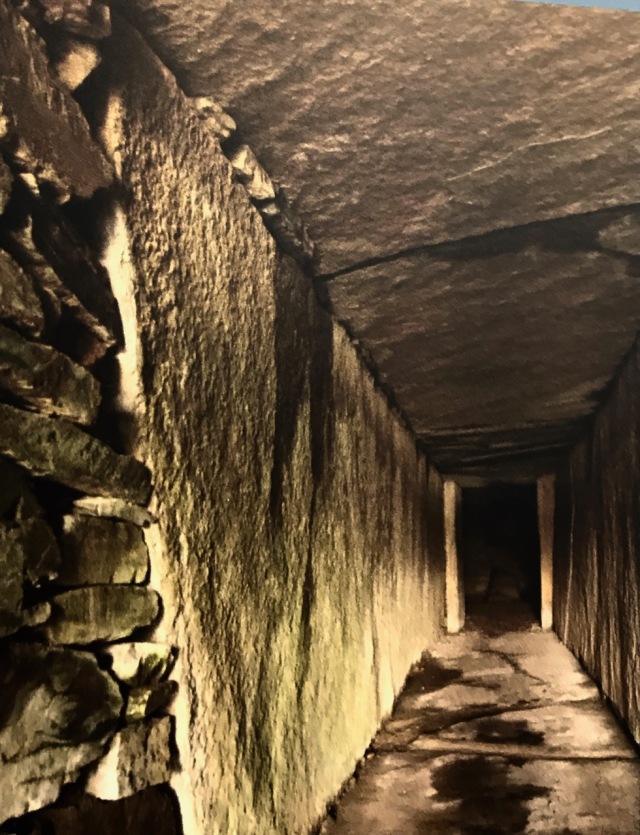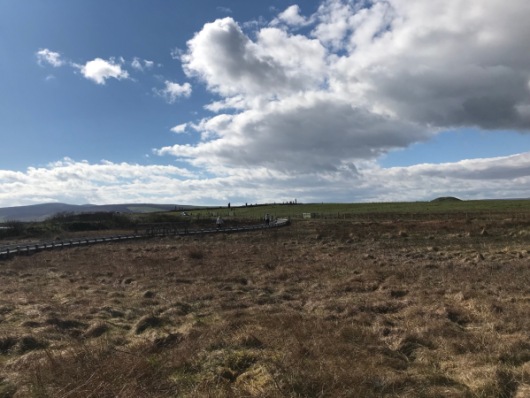To build something so sophisticated, so designed, as the Maeshowe Chambered ‘tomb’, would have required enormous dedication from the people of Orkney. Seen alongside the emerging splendour of the Ness of Brodgar ‘spiritual city’, you get a flavour of the total commitment of these ancient people to their task…
(1500 words, a ten-minute read)

The dark-haired one shivered in the gloom, pulling his heavy furs around him, licking the sweet drink from his lips – as much in nervousness as thirst. He had not expected the call; had not thought, those months ago, that he would be crouched here, waiting for something unknown, in the late afternoon of a freezing winter day…
Ahead, one of the three who had guarded him began to crawl along the passageway, leaving two; each with a firm hand on one of his shoulders. At the far end of the stone tunnel, the now-distant figure knocked on the large guardstone with a rock. For a long few seconds nothing happened, then there came the sound of the heavy stone being dragged to one side.
The darkness revealed in that distant and narrow aperture seemed to swirl the more he looked at it. His eyes adjusted to its near-black quality, thick with hidden purpose. He gazed as he had been instructed, looking for something unknown, his eyes becoming more acute with each passing heartbeat. The momentary flicker of gold shocked him with its intensity. He blinked, in case it had been a trick of being so long in the darkness. When his eyes returned to their focus, it was stronger – an arc of gold and red at the left edge of the far hole into the world and moving visibly, as he watched, to fill the small, black space.
The beauty was so intense, he could hardly bear it, and tears streamed down his cheeks, vapour rose off his face in swirling clouds that mixed with the rays of light coming from the world, splitting the incoming beams into jewels. The guards relaxed their grip and bent to whisper things in his ears: some clear, some at the edge of meaning and seemingly garbled. When they had finished, his whole being felt turned inside out and he only wanted one thing – to be released to crawl towards that place of the most beautiful light he had ever seen.
“Go!” The command came in unison from both. “Now, while the hole in the world is made bright, for you have become twice chosen.” Strong hands propelled his stiff limbs and he stumbled, half running, half crawling, along the stone passage towards the gold and red that was filling it.
The great arms that pulled him from the neck of that passageway drew him nearly into the air before pinning him back agains the cold stone; but he never took his eyes from the intensity of the bright sun blazing dead ahead in the black sky. In language he did not know, but would come to, it was bringing him to life, filling his depths with a calmness, purpose and belonging that he had never dreamed possible.
The twin grips on his flesh had changed. With the force there was now reverence. The four arms were changed to two, one over his forehead, one over his heart.
“I name you Priest, once chosen by the tribe,” sang the man on his left.
“I name you Priest, twice chosen. By the tribe and by the Sun, symbol of all life,” sang the other, the man whose hand was over his heart.
Ixra, twice chosen and anointed priest, holder of the heart of his people, felt their hands leave his flesh. Still staring at the red and gold orb, whose brilliance had begun to fade, he stretched out his hands to take theirs, that they could share in the fire now streaming from him.
I didn’t really understand the Maeshowe ‘Chambered Tomb’ the first time I saw it. You can’t walk to it from the visitor centre, you have to be taken by bus to a vehicle park parallel with it. The main road between Stromness and Kirkwall, the capital of Orkney, runs right past the Maeshowe site, so a guide walks you across from the bus park an onto the long walkway to the distant mound.

Initially, there’s not a lot to see. As you enter the walkway, the mound of Maeshowe looks a long way off.

The walkway passes through the large henge that surrounds Maeshowe. The interior may have been filled with water in the time of its active use, adding to the ‘birth symbolism’.

Maeshowe seems to have been built for one purpose: to honour and use the ritual power of the setting sun at midwinter – the solstice, the time of the shortest day and longest night. This point in the year is honoured in many temple structures in Scotland, including the remarkable ‘recumbent’ stone circle at East Aquhorthies, near Inverurie, a type only found in north-east Scotland. Allan Pringle and his wife, Ann, had conducted us on an excellent tour of the region three years prior.

You enter the interior the Maeshowe chamber by a long and low entrance passage on the south-western side of the mound. You have to crouch, uncomfortably, in the 28 inch vertical space, and the passageway is a long one – 36 feet.

The entrance passage was constructed using clay and and large native Orkney stones, each weighing as much as 30 tons. The entrance passage is made up of two sections. The outer passageway has been reconstructed due to damage prior to its excavation, but the the inner section is original.

At the point where the outer passage meets the inner, there is a recess containing a large stone that was used as a ‘blocking stone’, capable of being rolled back into the space to close the passageway.
The blocking stone doesn’t completely fill the aperture and this has led to speculation that this may be have been part of the design of the ‘light-entrance’ of the mound. Research has shown that it would have been easier to seal the mound from the inside. This underlines the widely held view that the chamber was used for rituals – and by a few people, only – a dedicated priesthood.

The entrance leads into the large central chamber, from which three smaller side-cells branch off. The image below, taken from the information boards, shows what must be a rare occurrence – given the time of year – of a bright far wall at the Winter solstice.

The skill of the Neolithic builders is evident once you are inside the main chamber. The drystone stonework is exact and of very high quality. The structure’s lower walls rise to a height of nearly five feet before they begin to slope inwards to finish in what would have once been a corbelled roof. Built into each of the three walls facing the entrance is a side chamber. It is thought these may have been used as depositories for the bodies of important ancestors… But no human remains were ever found here.

Maeshowe’s present roof is a modern one, installed in 1910, when the monument was taken into state care. Prior to this, and as confirmed by the above 1861 sketch of James Farrer, the chamber’s roof had not survived. The top of the structure was found to be already damaged during the excavation that year.
The excavators were only the latest in a series of visitors who had entered the structure by breaking through the roof! The most famous of these were a party of unknown but artistic Vikings who sought shelter here and left some spectacular graffiti on the sandstone walls.

Among this was a now-famous ‘dragon’, more likely to have been a wolf or lion, which has since become the basis of much Orkney jewellery…

I left Maeshowe feeling somewhat frustrated. A large group of us were packed into its compact space (remember this was 2018), but, more crucially for me, I was unable to take photographs, upon which I rely in my subsequent blog posts. Only later, when I reviewed my memories of how it felt, was I able to compose the thoughts of initiation that became the short imaginary piece that introduced this post. Maeshowe is one of the places where that was undeniably its purpose.
It’s certainly true to say that a normal tour of Maeshowe does not do justice to the obvious spiritual nature of the structure. That would be difficult for Historic Scotland to achieve. But if they’d like a volunteer as to how this could be done…

There was one more face to the area around the Ness of Brodgar: the Standing Stones of Stenness. We will visit them for our final post from the Neolithic part of Orkney, on Thursday.
Resources:
Wikipedia on Maeshowe
The excellent Orkneyjar website is a mine of information on Neolithic Orkney.
To be continued.
Other parts in this series:
Part One, Part Two, Part Three, Part Four, Part Five. This is Part Six.
The preceding Pictish Trail weekend blog posts:
Part One, Part Two, Part Three, Part Four, Part Five, Part Six, Part Seven, Part Eight, Part Nine
©Stephen Tanham, 2020.
Stephen Tanham is a Director of the Silent Eye – a journey through the forest of personality to the sunrise of Being.

Thank you, Sue x